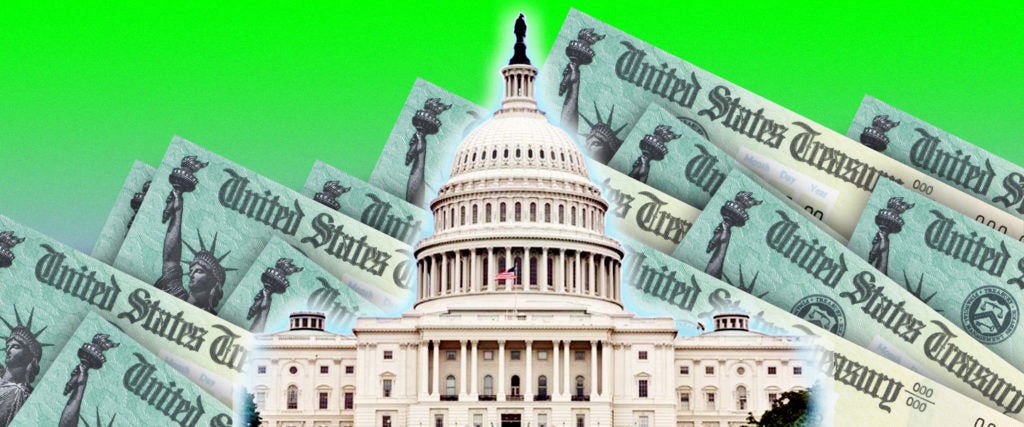When it’s politics, not cash flow, holding up another round of stimulus checks, do you ever wonder where exactly the government is getting all this money from? Like, aren’t we already 20-some trillion dollars in debt? How can politicians say there’s no money for things like universal health care or student-loan forgiveness, yet easily pop into a Money Machine Cash Cube when things truly go sideways? And while that money machine is on, can’t we simply grab enough cash to fix everything else that ails us, too?
It’s admittedly not cold hard cash, but alongside Stephen Brincks, finance professor at San Diego State University’s Fowler College of Business, we’re happy to send along some stimulating answers.
Okay, where are these additional trillions of dollars actually coming from?
The Treasury isn’t flipping on the switch to its money printers and making more paper dollars. Instead of raising taxes or cutting spending, the government basically writes checks to people and businesses, while simultaneously borrowing that money by issuing interest-bearing Treasury securities that can be purchased. Essentially, the government auctions off several hundred billions of dollars worth of such securities, which private investors buy, underwriting the stimulus in the process.
But doesn’t all this extra money created out of thin air cause inflation?
It sure does. Brincks says that’s why, in standard economic theory (especially Keynesian economics), governments should run surpluses during the good times, and deficits during the bad. Needless to say, Trump’s yuuuuuge tax cut in 2017 ensured that wasn’t gonna happen. Either way, when the economy contracts, you can expect to have deflationary forces at work — i.e., prices will fall because people will have less income.
In order to prevent that from happening, the government will increase transfers of money directly to people, like stimulus checks (a move that would normally cause inflation), which increases consumer spending, and theoretically, balances out the deflationary forces to a net zero.
Go on…
My pleasure — when the Treasury issues securities, the Federal Reserve ends up buying a lot of them. This pushes the yields lower, and almost every bank and lender in the country ties its interest rates to those of the federal government. As a result, interest rates on mortgages, auto loans, small-business loans, personal loans, etc. will become lower. And because things become more affordable, consumers start buying stuff, thus stimulating the economy.
Sounds great! Let’s do this all the time!
Right — it seems unfair to be constantly told the government has no money and then see it send out millions of large checks to people and businesses at the snap of its fingers.
But Brincks says that conventional economic theories state that when the economy is close to full employment, like it was pre-pandemic, that increased government spending will have a negative impact on the economy — as mentioned earlier, it will increase inflation, meaning everyone’s money is worth less. Plus, that sort of government spending would take away money from the private sector as investors would buy more Treasury bonds and fewer corporate bonds, since there’s only a fixed amount of investment money. “And if the economy is strong and there’s a demand for investment by private businesses, the net effect is going to be either a wash or negative,” Brincks explains.
Negative because, when businesses are faced with higher interest rates, they may not be able to get loans from banks, or enough investment to expand or undertake big projects.
I get that. But it still seems kinda like bullshit that the government won’t use its financial might to solve our other major woes.
Not really though. Brincks says the difference is the circumstances we’re currently in. This recession is unique; normally recessions are caused by an overinvestment in a particular sector, like dotcom companies at the turn of the century or housing/mortgages in 2008. But thanks to COVID-19, most businesses in most sectors were instantly on the brink of failure — not because anyone made bad decisions or overinvested, simply because there was a shock they never anticipated or prepared for.
The idea behind the stimulus packages is to prop up businesses during the pandemic, since they’d be otherwise functional and profitable, while the deflationary and inflationary forces hopefully cancel each other out.
As for covering the cost for things like universal health care and student-loan forgiveness, Brincks says that if you try to pay for everything, you end up (again, in theory) creating hyperinflation. This is particularly likely if a government gives money directly to individuals. “As opposed to if it’s going through the Federal Reserve, where often a lot of that money doesn’t directly make its way into the economy,” he explains, which tends to mitigate major inflation.
So you can make money out of thin air, you just gotta do it right?
Exactly. There’s a real art and science to this. But like Yogi Berra once said, it’s tough to make predictions… especially about the future. “This is going to be an area of active research with a lot of uncertainty going forward,” Brincks says. “Because you have such large budget deficits and now national debt, it’s uncertain what effect this will have in the longer term.”
In other words, all these trillions the government just materialized and instantly spent? Who knows if they’ll actually pay off.

